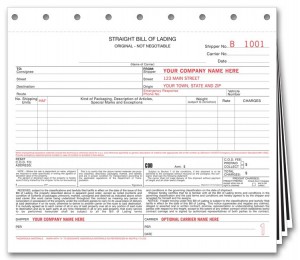What Are Carbon Copy Forms?
- Posted by admin
- on Sep, 19, 2013
- in Printing Tips
- Blog No Comments.
Technology Killed the Printing Star: Carbon Copy Forms
It seems like everything these days is done on a computer, tablet or smartphone. Everything from making dinner reservations to preparing for a business meeting can be done with a swipe of your finger or the pressing of a key. With the change in technology, the printing industry needs to change as well, making sure to stay relevant.
One product that has been affected not only by the accessibility of technology but also the convenience of similar products is carbon copy forms. These forms require carbon paper to transfer information from an original document onto another sheet to create “carbon copies”.
Carbon paper was created in the early nineteenth century to be used in a very unique way. Carbon paper, or ‘Black Paper’ as it was known, was used with early forms of what could be considered today to resemble a typewriter. Originally, it was created to help people suffering from blindness to write. After existing for almost 20 years, the potential for it to be used for business purposes was discovered. The process of applying a black wax to the back of paper became perfected, creating the carbon paper we use today.
we use today.
Though this product was created over 200 years ago, carbon paper still has a place in the business world today. Hundreds of carbon copy products are still offered by printing companies around the world in the form of carbon copy business forms. Though it is less common than the now wide spread use of NCR (No Carbon Required) paper, carbon inserts are still featured on many types of business forms.
Businesses are using carbon copy forms in many different ways. Most commonly, this type of forms is used for sales receipts, purchase orders, statements, and bills of lading. Exact copies of the original can be made by placing carbon inserts in between each page, allowing you to pick the amount of copies you would like.
Fun Fact:
When you forward an email to other recipients it is called being “cc’d”. The “cc:” placed next to the forwarding email address stands for “carbon copy”. Though there is no carbon involved, it has become a recognizable term associated with an exact replica of information.
There are some downsides to using carbon copy forms. Carbon inserts are known for being messy. Carbon from the inserts can rub off onto your fingers and momentarily stain them with a shade of dark grey. There is also a limit to how many carbon copies can be made with these forms. Typically, carbon copy forms come with two carbon inserts as the pressure cannot easily be transferred beyond the fourth or fifth copy.
Though the use of carbon paper has declined, it managed to ward off extinction even after the introduction of carbonless copy paper and the photocopier. It is likely that businesses will continue to use this form of documentation until there comes a time when all transactions can be done digitally.
Recent Posts
- The Ultimate Guide to Carbonless Forms
- Are Accounts Payable Business Checks Always on Top of a Laser Sheet?
- Complete Guide to Making a Perfect Thank You Card
- Beyond Business Cards: Embracing Innovative Networking Print Solutions
- Printed Catalogs: Reviving a Classic Marketing Tool for Modern Businesses
Categories
- By Industry
- Accountants
- Automotive Professionals
- Bakery Shop Owners
- Beauty Industry
- Contractors
- Dentists
- Education Workers
- Electricians
- Engineers
- Florists
- Graphic Designers
- Hotel Industry
- Insurance Industry
- Jewelry Store Owners
- Landscaping/Gardening
- Legal Industry
- Medical Industry
- Non-Profit-Sector
- Optical Industry
- Pet Store Owners
- Photographers
- Realtors
- Restaurant Owners
- Shipping Company Owners
- Design Tips
- Holiday
- Marketing Tips
- Printing Resources
- Printing Tips
- Small Business Tips
Recent Comments
Common Tags
Calendar
| M | T | W | T | F | S | S |
|---|---|---|---|---|---|---|
| 1 | 2 | 3 | 4 | 5 | 6 | |
| 7 | 8 | 9 | 10 | 11 | 12 | 13 |
| 14 | 15 | 16 | 17 | 18 | 19 | 20 |
| 21 | 22 | 23 | 24 | 25 | 26 | 27 |
| 28 | 29 | 30 | 31 | |||
